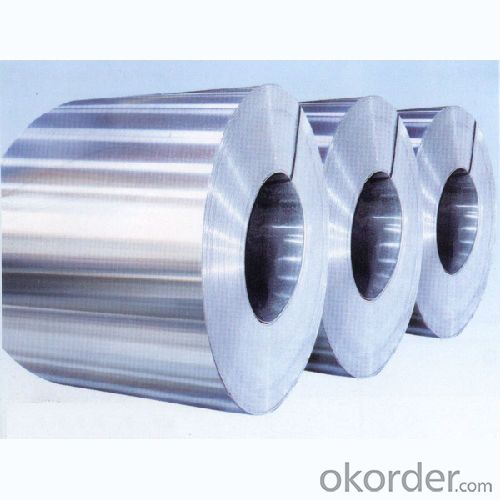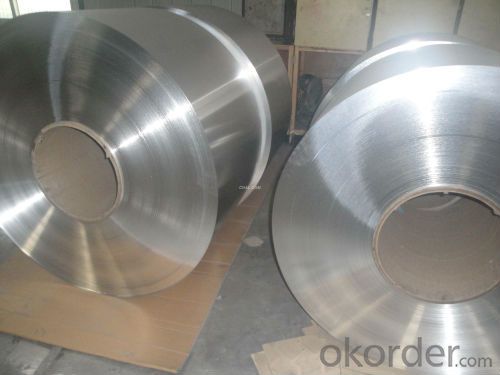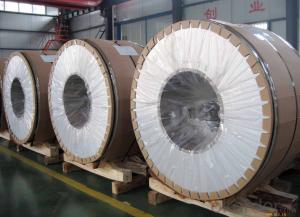Aluminum Mill Finished strips 8XXX Used in Construction
- Loading Port:
- China main port
- Payment Terms:
- TT or LC
- Min Order Qty:
- 8 g/ft
- Supply Capability:
- 100000 g/ft/month
OKorder Service Pledge
OKorder Financial Service
You Might Also Like
1.Structure of Aluminum Mill Finished strips 8XXX Used in Construction Description
Aluminum Mill Finished strips 8XXX Used in Construction has great ductility, heat conductivity, anti-corrosion and moisture resistance properties.
Aluminum Mill Finished strips 8XXX Used in Construction is widely used for PP cap stock, hot rolled thick plate, PS base plate, aluminum curtain wall base plate, the traffic sign ,air-conditioner heat and exchangers, food container, household foil, pharmaceutical packing, cigarettes packing.
2.Main Features of Aluminum Mill Finished strips 8XXX Used in Construction
• Superior quality of raw material
• Reasonable and stable chemical composition
• Accurate tolerance
• Goode mechanical property
3.Aluminum Mill Finished strips 8XXX Used in Construction Images



4.Aluminum Mill Finished strips 8XXX Used in Construction Specification
Alloy | AA8xxx (AA8011 etc) |
Temper | H14, H16, H18, H22, H24, H26, H32, O/F |
Thickness | 0.2mm -- 100mm |
Width | 30mm -- 1700mm |
Standard | GB/T 3880-2006,EN,ASTM,JIS |
5. FAQ of Aluminum Mill Finished strips 8XXX Used in Construction
A.How to guarantee the quality?
Customers are welcome to our mill to visit and check the products. Besides, we can arrange a third party to test Aluminum Mill Finished strips 8XXX Used in Construction.
B.When will you deliver the products?
Aluminum Mill Finished strips 8XXX Used in Construction will be delivered within 35 days after receiving advanced payment or original L/C.
- Q:Can aluminum coils be used in the production of aluminum doors?
- Yes, aluminum coils can be used in the production of aluminum doors. Aluminum coils are typically used as a raw material in the manufacturing process of aluminum doors. These coils are made from high-quality aluminum alloy and are available in various thicknesses and widths. They can be easily formed into different shapes and sizes to meet the specific requirements of the doors. Additionally, aluminum coils are lightweight, durable, and resistant to corrosion, making them an ideal choice for door production. The coils are often processed through various techniques such as cutting, bending, and welding to create the desired door components. Overall, aluminum coils offer many advantages in terms of versatility, strength, and aesthetics, making them a popular choice for aluminum door manufacturers.
- Q:What happens when you mix Aluminum (or magnesium) with calcium carbonate? Can you write a chemical equation please?
- Neither aluminium nor magnesium will react with calcium carbonate. The suggested displacement reaction would only occur if aluminium or magnesium were more electropositive than calcium. Electrode potential data shows that this is not the case. Calcium is more electropositive than both aluminium and magnesium.
- Q:What are the dimensions of an aluminum coil?
- The intended use and manufacturing specifications of an aluminum coil can lead to variations in its dimensions. Typical dimensions for an aluminum coil typically fall within a range of 0.2mm to 8mm in thickness and 200mm to 2000mm in width. As for length, it can vary and is usually customized to meet the specific requirements of the customer. Furthermore, the weight of an aluminum coil is subject to change based on its thickness and dimensions.
- Q:How do aluminum coils contribute to energy-efficient appliances?
- Enhancing the energy efficiency of appliances is a key role played by aluminum coils. The utilization of aluminum in the form of coils enables efficient transfer of heat, which is vital for appliances that require cooling or heating mechanisms. To begin with, the thermal conductivity of aluminum coils is exceptional. This implies that they can rapidly absorb and dissipate heat, resulting in more efficient cooling or heating procedures. This is particularly significant in appliances like refrigerators, air conditioners, and heat pumps, where effective heat transfer is crucial for maintaining the desired temperature. In addition, aluminum coils are lightweight yet durable, making them an ideal option for energy-efficient appliances. The lightweight nature of aluminum reduces the overall weight of the appliance, leading to lower energy consumption during transportation and installation. Furthermore, the durability of aluminum ensures a longer lifespan for the appliance, reducing the need for frequent maintenance or replacement. Furthermore, aluminum exhibits high resistance to corrosion, a common issue in appliances that come into contact with water or moisture. By incorporating aluminum coils, manufacturers can ensure the longevity and reliability of the appliance, thereby contributing to energy efficiency by minimizing the need for repairs or replacements. Lastly, aluminum is a highly recyclable material. The use of aluminum coils in appliances promotes sustainability and reduces the environmental impact. By opting for energy-efficient appliances that integrate aluminum coils, consumers can support the circular economy and contribute to a more sustainable future. In conclusion, aluminum coils significantly contribute to the energy efficiency of appliances. Their exceptional thermal conductivity, lightweight yet durable nature, corrosion resistance, and recyclability make them an ideal choice for enhancing the performance and sustainability of energy-efficient appliances.
- Q:What are the potential applications of perforated aluminum coils?
- Perforated aluminum coils have a wide range of potential applications. They can be used in architectural and construction projects for decorative purposes, such as facades, ceilings, and wall cladding. They are also commonly utilized in the automotive industry for grilles and ventilation systems. Additionally, perforated aluminum coils find application in the manufacturing of filters, screens, and acoustic panels due to their ability to efficiently control airflow and sound. The versatility of perforated aluminum coils makes them suitable for various industries, including aerospace, marine, and electronics, where lightweight and corrosion-resistant materials are required.
- Q:Can aluminum coils be used in the manufacturing of lighting fixtures?
- Yes, aluminum coils can be used in the manufacturing of lighting fixtures. Aluminum is a lightweight and durable material that is commonly used in various industries, including the lighting industry. It offers excellent heat dissipation properties, making it suitable for fixtures that generate heat, such as LED lights. Additionally, aluminum coils can be easily shaped and molded into different designs, making them a versatile choice for lighting fixture production.
- Q:Are there any specific maintenance requirements for aluminum coils?
- Yes, there are specific maintenance requirements for aluminum coils. Aluminum coils are commonly used in HVAC systems and require regular cleaning and maintenance to ensure optimal performance and longevity. Some of the maintenance requirements for aluminum coils include: 1. Cleaning: Regular cleaning of aluminum coils is necessary to prevent the buildup of dirt, dust, and other contaminants. This can be done using a soft brush or a vacuum cleaner with a brush attachment. It is important to clean both the fins and the surface of the coils to ensure proper airflow. 2. Inspection: Regular inspection of aluminum coils is essential to identify any signs of damage or corrosion. Look for any bent fins, leaks, or signs of wear and tear. If any issues are detected, they should be addressed immediately to prevent further damage. 3. Coil Protection: Applying a protective coating to aluminum coils can help prevent corrosion and extend their lifespan. There are various coatings available in the market specifically designed for aluminum coils, which can provide an additional layer of protection against environmental factors. 4. Air Filter Maintenance: The air filters in HVAC systems play a crucial role in maintaining the cleanliness of the coils. It is important to regularly clean or replace the air filters to prevent the accumulation of dust and debris on the coils. Clogged filters can restrict airflow and reduce the efficiency of the system. 5. Regular Maintenance Schedule: Creating a regular maintenance schedule is essential to ensure that all necessary maintenance tasks are performed on time. This can include cleaning, inspection, and any other specific requirements recommended by the manufacturer. It is important to consult the manufacturer's guidelines and recommendations for specific maintenance requirements for aluminum coils, as they may vary depending on the type of system and application. Following these maintenance requirements can help ensure that aluminum coils function efficiently and have a longer lifespan.
- Q:Foshan where there are high-quality aluminum and aluminum rolls for sale?
- If you know where to use, or what are the requirements of the words I can occasionally recommend you manufacturers give you, because I am in this industry!
- Q:How do aluminum coils compare to copper coils?
- Aluminum coils are generally lighter and less expensive than copper coils, but they have lower thermal conductivity and may require larger coil sizes. Copper coils, on the other hand, have superior heat transfer properties, making them more efficient for cooling or heating applications.
- Q:my homework was to find out how do you get aluminium for rocks! I've been looking around but every web site i've been on only says that aluminium comes from rocks, but it doesn't say how you get it from rocks.e.g you get wool from sheep by shearing of their coat.so if anyone knows how you get aluminum from rocks please tell me i need your help.
- Well, you start with an aluminum rich rock (cheaper to process). The raw ore after physical concentration (removal of secondary minerals) is reacted by an electrolytic process. This means that electricity is used to convert the aluminum ion in the raw rock into the metal aluminum. Sort of like the reverse of a battery, to keep things simple. Aluminum smelters tend to be set up in places with cheap electricity, because the process uses a LOT of electricity. That is why there are several up here in quebec, we have cheap hydro electricity and the government gives decent deals to the smelters on top of the already low market price. Do a search on aluminum smelting to find out more. Not sure what your level of knowledge is so not sure how much you will understand.
1. Manufacturer Overview |
|
|---|---|
| Location | |
| Year Established | |
| Annual Output Value | |
| Main Markets | |
| Company Certifications | |
2. Manufacturer Certificates |
|
|---|---|
| a) Certification Name | |
| Range | |
| Reference | |
| Validity Period | |
3. Manufacturer Capability |
|
|---|---|
| a)Trade Capacity | |
| Nearest Port | |
| Export Percentage | |
| No.of Employees in Trade Department | |
| Language Spoken: | |
| b)Factory Information | |
| Factory Size: | |
| No. of Production Lines | |
| Contract Manufacturing | |
| Product Price Range | |
Send your message to us
Aluminum Mill Finished strips 8XXX Used in Construction
- Loading Port:
- China main port
- Payment Terms:
- TT or LC
- Min Order Qty:
- 8 g/ft
- Supply Capability:
- 100000 g/ft/month
OKorder Service Pledge
OKorder Financial Service
Similar products
New products
Hot products
Related keywords






























